Nonlinear Frequency Offset Beam Design for FDA-MIMO Radar
Abstract
:1. Introduction
2. System Model
3. Chebyshev Window Weighted Linear Frequency Offsets
4. MVDR Algorithm Model
5. Simulation and Analysis
5.1. Simulation of Frequency Offset Scheme
5.2. Analysis of the Anti-Jamming Characteristics of the Proposed Scheme
6. Experimental Results and Discussion
Author Contributions
Funding
Institutional Review Board Statement
Informed Consent Statement
Data Availability Statement
Conflicts of Interest
References
- Antonik, P.; Wicks, M.C.; Griffiths, H.D.; Baker, C.J. Frequency diverse array radars. In Proceedings of the 2006 IEEE Conference on Radar, Verona, NY, USA, 24–27 April 2006; IEEE: Piscataway, NJ, USA, 2006; pp. 215–217. [Google Scholar]
- Wang, W.-Q. Overview of frequency diverse array in radar and navigation applications. IET Radar Sonar Navig. 2016, 6, 1001–1012. [Google Scholar] [CrossRef]
- So, H.C.; Amin, M.G.; Blunt, S.; Gini, F.; Wang, W.-Q. Introduction to the special issue on time-frequency modulated array signal processing. IEEE J. Sel. Top. Signal Process. 2020, 2, 225–227. [Google Scholar]
- Xu, J.; Liao, G.; Zhu, S.; Huang, L.; So, H.C. Joint range and angle estimation using MIMO radar with frequency diverse array. IEEE Trans. Signal Process. 2015, 13, 3396–3410. [Google Scholar] [CrossRef]
- Xu, J.; Zhu, S.; Liao, G.; Zhang, Y. An Overview of Frequency Diverse Array Radar Technology. J. Radars 2018, 7, 167–182. [Google Scholar]
- Chen, H.; Wang, W.-Q.; Cui, Y.-S.; Liao, Y. Statistical analysis for time modulation-based frequency diverse array beam-pattern. IEEE Access 2019, 7, 84142–84154. [Google Scholar] [CrossRef]
- Cheng, Q.; Zhu, J.; Xie, T.; Luo, J.; Xu, Z. Time-invariant angle-range dependent directional modulation based on time-modulated frequency diverse arrays. IEEE Access 2017, 5, 26279–26290. [Google Scholar] [CrossRef]
- Xu, J.; Kang, J.; Liao, G.; So, H.C. Mainlobe deceptive jammer suppression with FDA-MIMO radar. In Proceedings of the 2018 IEEE 10th Sensor Array and Multichannel Signal Processing Workshop (SAM), Sheffield, UK, 8–11 July 2018; IEEE: Piscataway, NJ, USA; pp. 504–508. [Google Scholar]
- Lan, L.; Liao, G.; Xu, J.; Zhang, Y.; Fioranelli, F. Suppression approach to main-beam deceptive jamming in FDA-MIMO radar using nonhomogeneous sample detection. IEEE Access 2018, 6, 34582–34597. [Google Scholar] [CrossRef]
- Tan, M.; Wang, C.; Li, Z. Correction analysis of frequency diverse array radar about time. IEEE Trans. Antennas Propag. 2021, 69, 834–847. [Google Scholar] [CrossRef]
- Xu, Y.; Shi, X.; Li, W.; Xu, J.; Huang, L. Low-sidelobe range-angle beamforming with FDA using multiple parameter optimization. IEEE Trans. Aerosp. Electron. Syst. 2019, 55, 2214–2225. [Google Scholar] [CrossRef]
- Khan, W.; Qureshi, I.M.; Saeed, S. Frequency diverse array radar with logarithmically increasing frequency offset. IEEE Antennas Wirel. Propag. Lett. 2015, 14, 499–502. [Google Scholar] [CrossRef]
- Xu, Y.; Xu, J. Corrections to range-angle-dependent beamforming of pulsed-frequency diverse array. IEEE Trans. Antennas Propag. 2018, 66, 6466–6468. [Google Scholar] [CrossRef]
- Lan, L.; Liao, G.; Xu, J.; Wen, J. Range-angle pencil-beamforming for non-uniformly distributed array radar. Multidimens. Syst. Signal Process. 2018, 29, 867–886. [Google Scholar] [CrossRef]
- Basit, A.; Qureshi, I.M.; Khan, W.; Rehman, S.U.; Khan, M.M. Beam Pattern Synthesis for an FDA Radar with Hamming Window-Based Nonuniform Frequency Offset. IEEE Antennas Wirel. Propag. Lett. 2017, 16, 2283–2286. [Google Scholar] [CrossRef]
- Zhou, C.; Wang, C.; Gong, J.; Tan, M.; Zhao, Y.; Liu, M. FDA-MIMO Beampattern Synthesis with an Analytical Method. Int. J. Aerosp. Eng. 2021, 2021, 9051131. [Google Scholar] [CrossRef]
- Tan, M.; Wang, C.; Yuan, H.; Bai, J.; An, L. FDA-MIMO Beampattern Synthesis with Hamming Window Weighted Linear Frequency Increments. Int. J. Aerosp. Eng. 2020, 2020, 4851909. [Google Scholar] [CrossRef] [Green Version]
- Basit, A.; Wang, W.; Nusenu, S. Adaptive transmit array sidelobe control using FDA-MIMO for tracking in joint radar-communications. Digit. Signal Process. 2020, 97, 102619. [Google Scholar] [CrossRef]
- Lan, L.; Liao, G.; Xu, J.; Zhu, S.; Zhang, Y. Range-angle-dependent beamforming for FDA-MIMO radar using oblique projection. Sci. China Inf. Sci. 2022, 65, 152305. [Google Scholar] [CrossRef]
- Lan, L.; Liao, G.; Xu, J.; Zhang, Y.; Liao, B. Transceive Beamforming With Accurate Nulling in FDA-MIMO Radar for Imaging. IEEE Trans. Geosci. Remote Sens. 2020, 58, 4145–4159. [Google Scholar] [CrossRef]
- Wen, F.; Gui, G.; Gacanin, H.; Sari, H. Compressive sampling framework for 2D-DOA and polarization estimation in mmWave polarized massive MIMO systems. IEEE Trans. Wirel. Commun. 2022. [Google Scholar] [CrossRef]
- Wen, F.; Shi, J.; Gui, G. 3D Positioning method for anonymous UAV based on bistatic polarized MIMO radar. IEEE Internet Things J. 2023, 10, 815–827. [Google Scholar] [CrossRef]
- Liao, Y.; Tang, H.; Chen, X.; Wang, W.-Q. Frequency Diverse Array Beampattern Synthesis With Taylor Windowed Frequency Offsets. IEEE Antennas Wirel. Propag. Lett. 2020, 19, 1901–1905. [Google Scholar] [CrossRef]
- Sun, Z.; Huang, J.; Yang, J.; Zang, T.; He, Z. A High Accuracy Analysis Method of Harmonic/Interharmonic in Power System Based on Chebyshev Window. Autom. Electr. Power Syst. 2015, 39, 117–123. [Google Scholar]

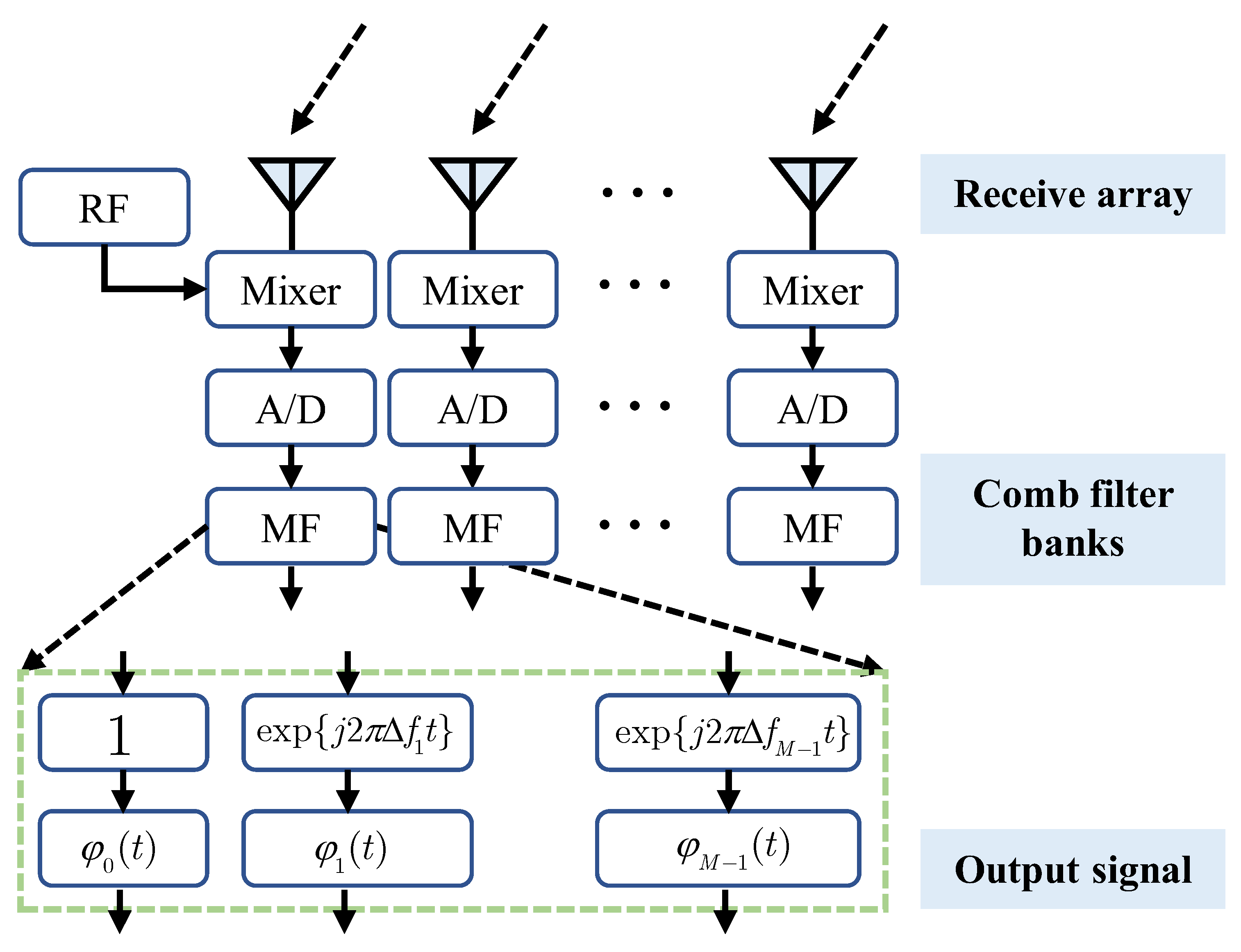
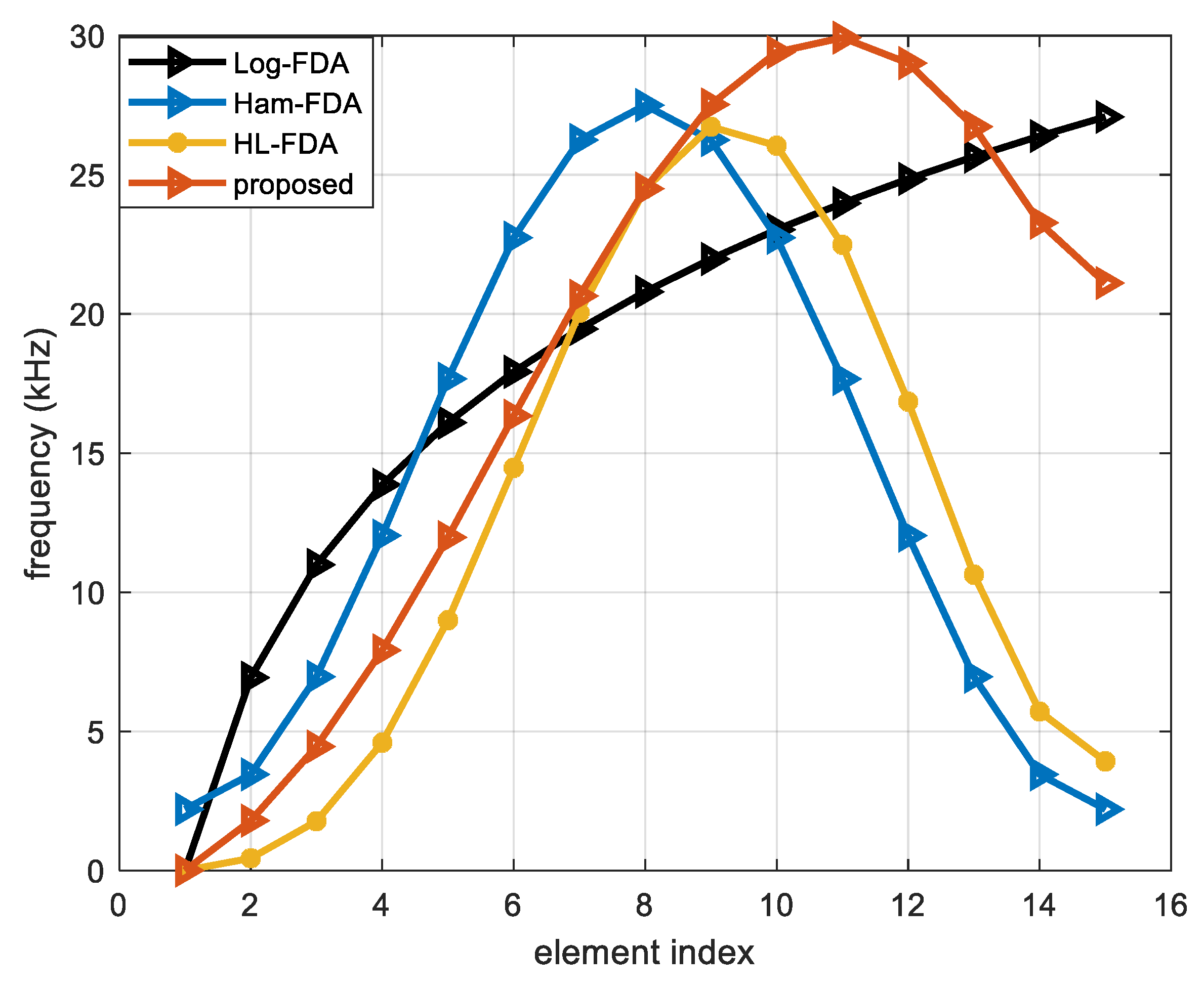
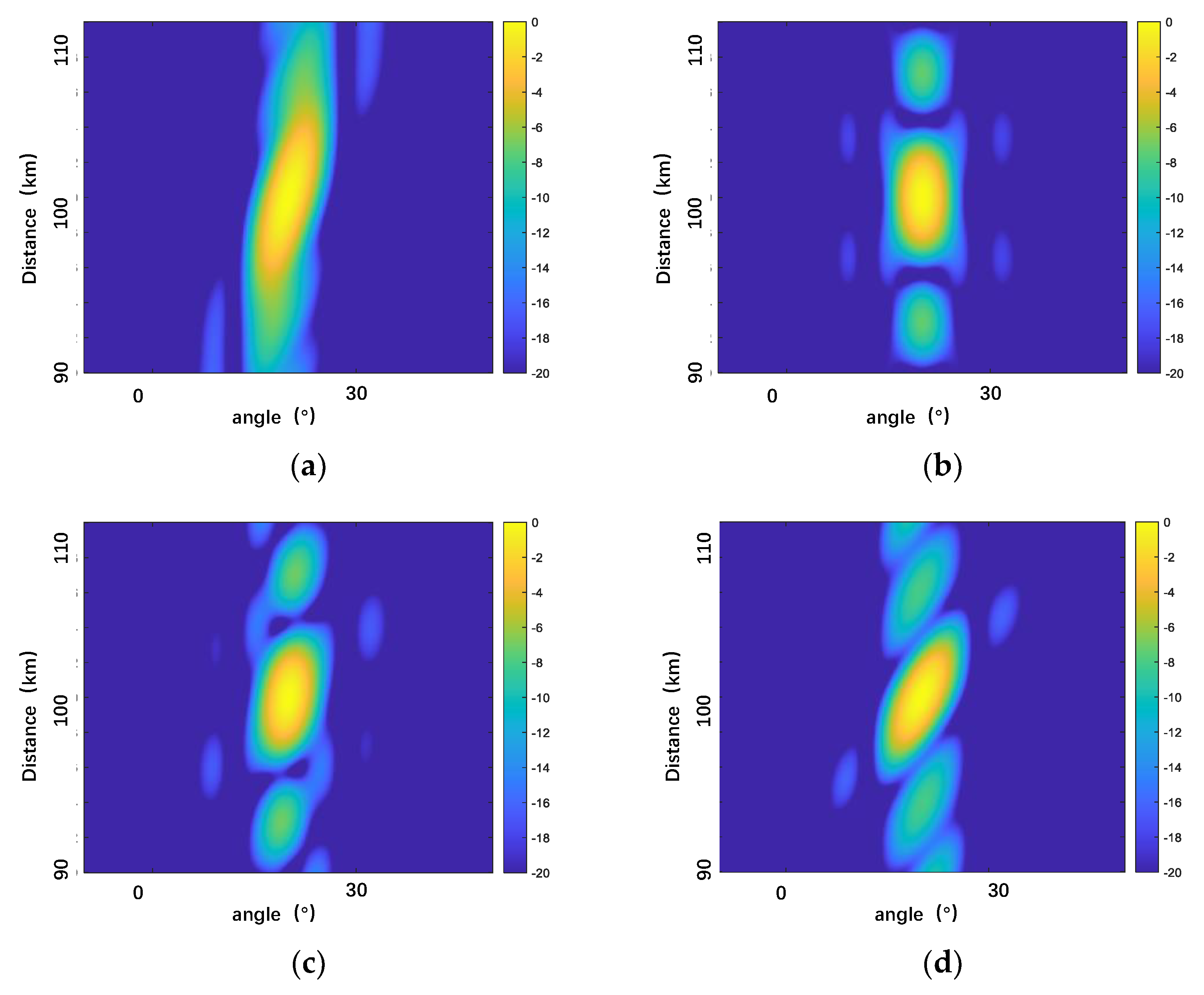
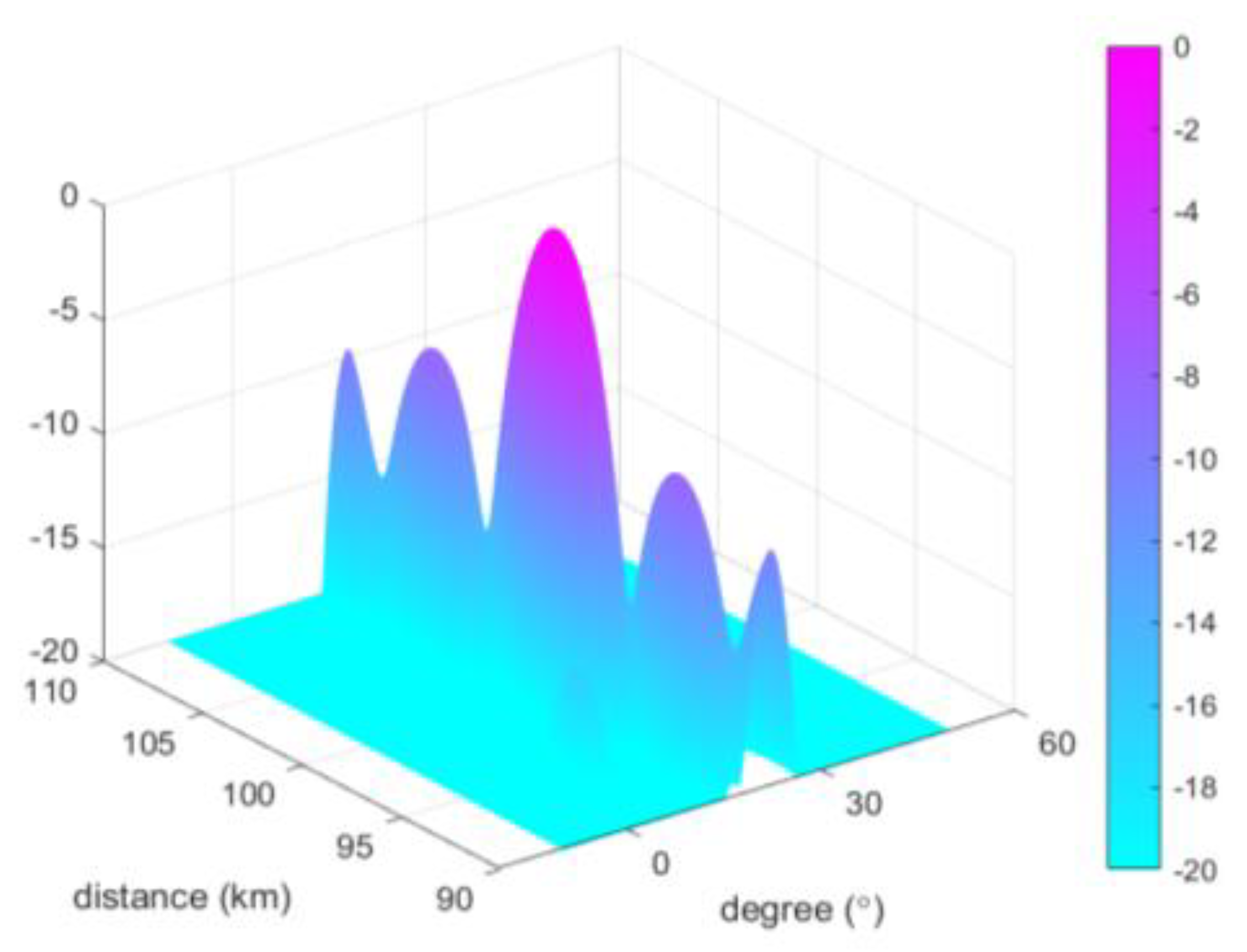

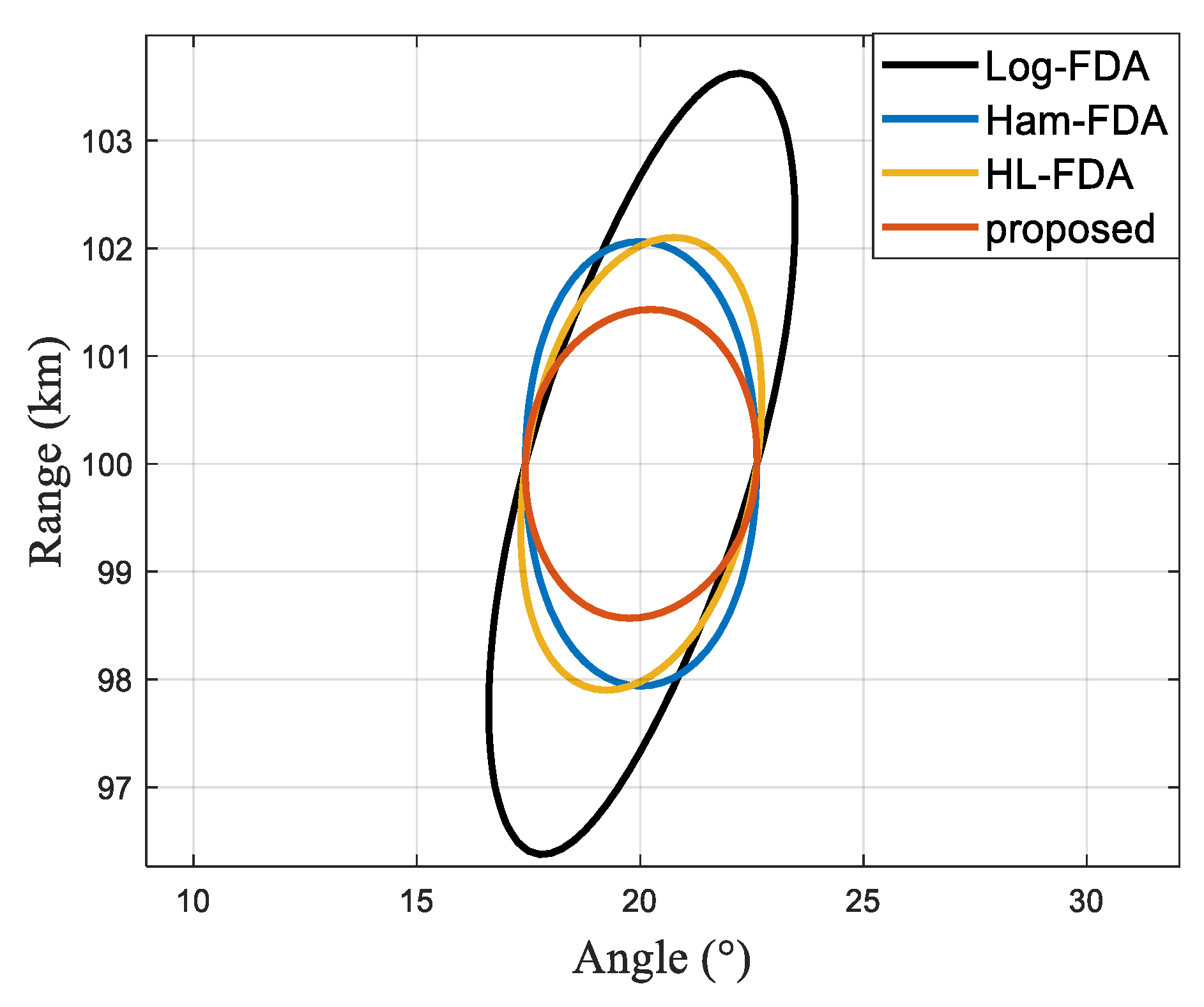


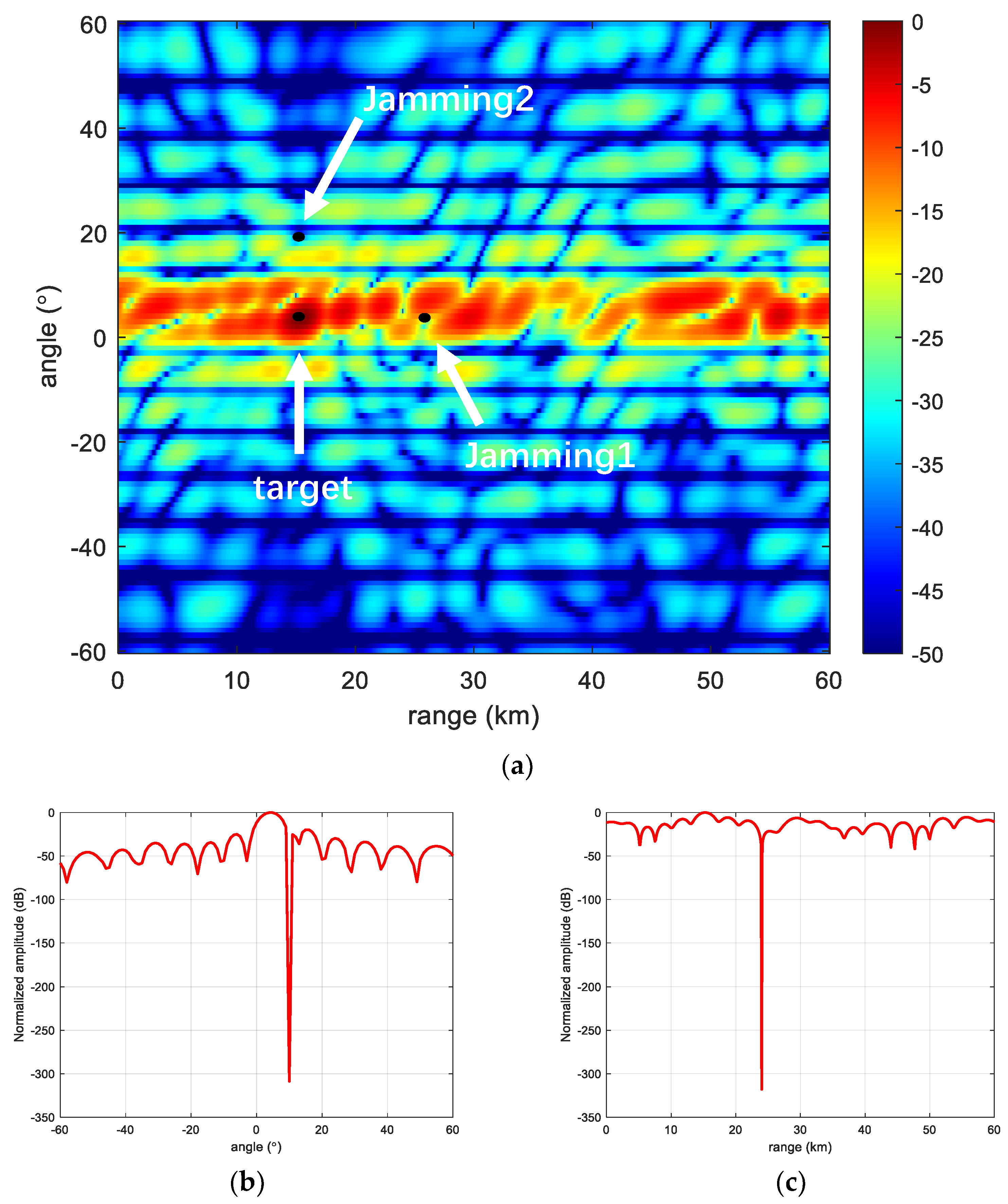
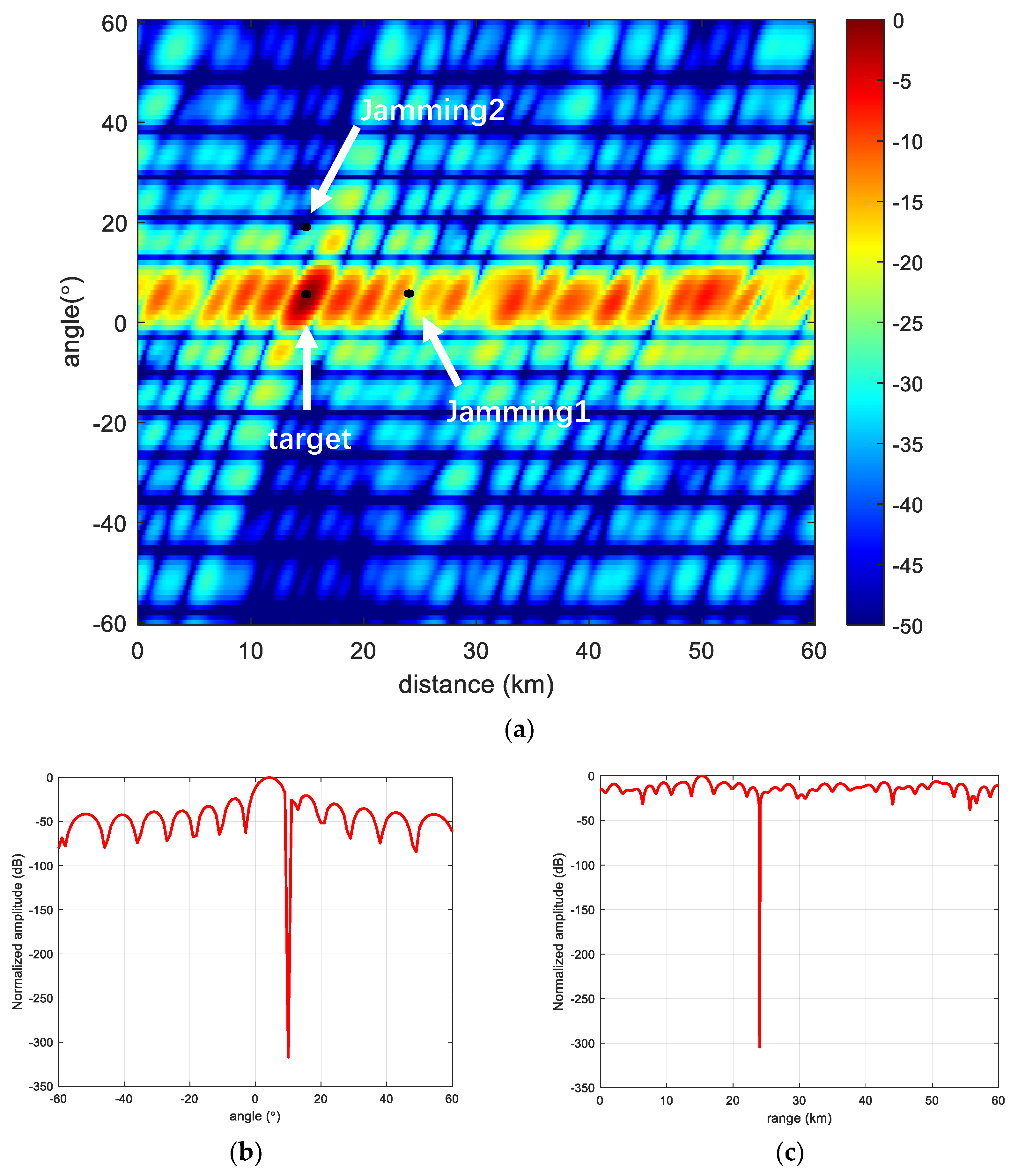
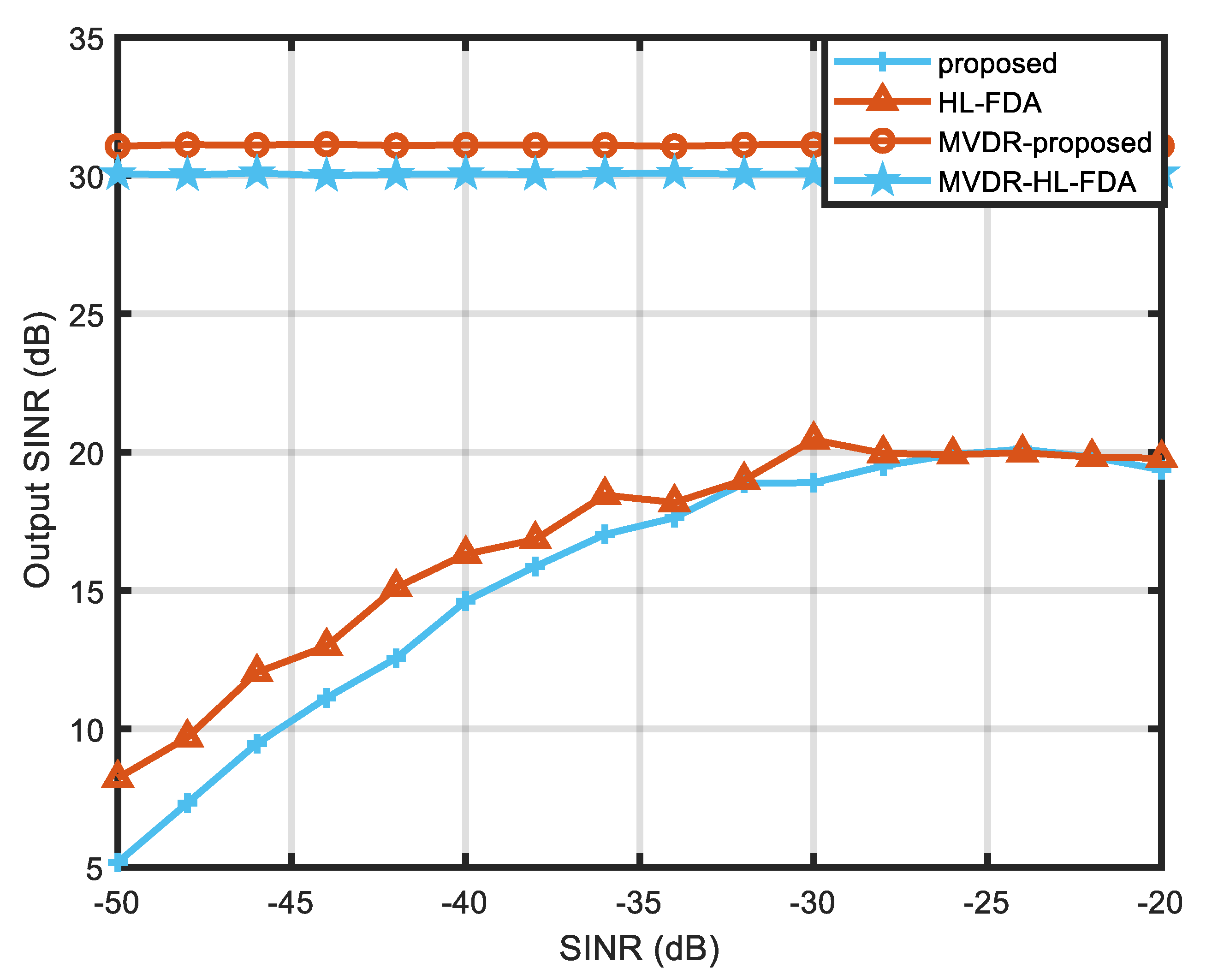
Disclaimer/Publisher’s Note: The statements, opinions and data contained in all publications are solely those of the individual author(s) and contributor(s) and not of MDPI and/or the editor(s). MDPI and/or the editor(s) disclaim responsibility for any injury to people or property resulting from any ideas, methods, instructions or products referred to in the content. |
© 2023 by the authors. Licensee MDPI, Basel, Switzerland. This article is an open access article distributed under the terms and conditions of the Creative Commons Attribution (CC BY) license (https://creativecommons.org/licenses/by/4.0/).
Share and Cite
Xu, Y.; Wang, C.; Zheng, G.; Tan, M. Nonlinear Frequency Offset Beam Design for FDA-MIMO Radar. Sensors 2023, 23, 1476. https://doi.org/10.3390/s23031476
Xu Y, Wang C, Zheng G, Tan M. Nonlinear Frequency Offset Beam Design for FDA-MIMO Radar. Sensors. 2023; 23(3):1476. https://doi.org/10.3390/s23031476
Chicago/Turabian StyleXu, Yanjie, Chunyang Wang, Guimei Zheng, and Ming Tan. 2023. "Nonlinear Frequency Offset Beam Design for FDA-MIMO Radar" Sensors 23, no. 3: 1476. https://doi.org/10.3390/s23031476





